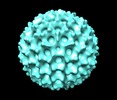+ Open data
Open data
- Basic information
Basic information
| Entry | Database: EMDB / ID: EMD-20593 | |||||||||
|---|---|---|---|---|---|---|---|---|---|---|
| Title | Rotavirus, transcriptionally active | |||||||||
 Map data Map data | Rotavirus actively transcribing | |||||||||
 Sample Sample |
| |||||||||
| Biological species |  Simian rotavirus A/SA11-4F Simian rotavirus A/SA11-4F | |||||||||
| Method | single particle reconstruction / cryo EM / Resolution: 12.0 Å | |||||||||
 Authors Authors | Kelly DF / Hauser M | |||||||||
| Funding support |  United States, 2 items United States, 2 items
| |||||||||
 Citation Citation |  Journal: Comput Struct Biotechnol J / Year: 2019 Journal: Comput Struct Biotechnol J / Year: 2019Title: Cryo-EM Reveals Architectural Diversity in Active Rotavirus Particles. Authors: Mary Hauser / William J Dearnaley / A Cameron Varano / Michael Casasanta / Sarah M McDonald / Deborah F Kelly /  Abstract: Rotavirus is a well-studied RNA virus that causes severe gastroenteritis in children. During viral entry, the outer layer of the virion is shed, creating a double-layered particle (DLP) that is ...Rotavirus is a well-studied RNA virus that causes severe gastroenteritis in children. During viral entry, the outer layer of the virion is shed, creating a double-layered particle (DLP) that is competent to perform viral transcription (i.e., mRNA synthesis) and launch infection. While inactive forms of rotavirus DLPs have been structurally characterized in detail, information about the transcriptionally-active DLP remains limited. Here, we used cryo-Electron Microscopy (cryo-EM) and 3D image reconstructions to compare the structures of internal protein components in transcriptionally-active versus inactive DLPs. Our findings showed that transcriptionally-active DLPs gained internal order as mRNA synthesis unfolded, while inactive DLPs remained dynamically disordered. Regions of viral protein/RNA constituents were analyzed across two different axes of symmetry to provide a more comprehensive view of moving components. Taken together, our results bring forth a new view of active DLPs, which may enable future pharmacological strategies aimed at obliterating rotavirus transcription as a therapeutic approach. | |||||||||
| History |
|
- Structure visualization
Structure visualization
| Movie |
 Movie viewer Movie viewer |
|---|---|
| Structure viewer | EM map:  SurfView SurfView Molmil Molmil Jmol/JSmol Jmol/JSmol |
| Supplemental images |
- Downloads & links
Downloads & links
-EMDB archive
| Map data |  emd_20593.map.gz emd_20593.map.gz | 14.5 MB |  EMDB map data format EMDB map data format | |
|---|---|---|---|---|
| Header (meta data) |  emd-20593-v30.xml emd-20593-v30.xml emd-20593.xml emd-20593.xml | 10.9 KB 10.9 KB | Display Display |  EMDB header EMDB header |
| Images |  emd_20593.png emd_20593.png | 134.1 KB | ||
| Archive directory |  http://ftp.pdbj.org/pub/emdb/structures/EMD-20593 http://ftp.pdbj.org/pub/emdb/structures/EMD-20593 ftp://ftp.pdbj.org/pub/emdb/structures/EMD-20593 ftp://ftp.pdbj.org/pub/emdb/structures/EMD-20593 | HTTPS FTP |
-Validation report
| Summary document |  emd_20593_validation.pdf.gz emd_20593_validation.pdf.gz | 77.9 KB | Display |  EMDB validaton report EMDB validaton report |
|---|---|---|---|---|
| Full document |  emd_20593_full_validation.pdf.gz emd_20593_full_validation.pdf.gz | 77 KB | Display | |
| Data in XML |  emd_20593_validation.xml.gz emd_20593_validation.xml.gz | 494 B | Display | |
| Arichive directory |  https://ftp.pdbj.org/pub/emdb/validation_reports/EMD-20593 https://ftp.pdbj.org/pub/emdb/validation_reports/EMD-20593 ftp://ftp.pdbj.org/pub/emdb/validation_reports/EMD-20593 ftp://ftp.pdbj.org/pub/emdb/validation_reports/EMD-20593 | HTTPS FTP |
-Related structure data
| Related structure data | C: citing same article ( |
|---|---|
| Similar structure data |
- Links
Links
| EMDB pages |  EMDB (EBI/PDBe) / EMDB (EBI/PDBe) /  EMDataResource EMDataResource |
|---|
- Map
Map
| File |  Download / File: emd_20593.map.gz / Format: CCP4 / Size: 30.5 MB / Type: IMAGE STORED AS FLOATING POINT NUMBER (4 BYTES) Download / File: emd_20593.map.gz / Format: CCP4 / Size: 30.5 MB / Type: IMAGE STORED AS FLOATING POINT NUMBER (4 BYTES) | ||||||||||||||||||||||||||||||||||||||||||||||||||||||||||||
|---|---|---|---|---|---|---|---|---|---|---|---|---|---|---|---|---|---|---|---|---|---|---|---|---|---|---|---|---|---|---|---|---|---|---|---|---|---|---|---|---|---|---|---|---|---|---|---|---|---|---|---|---|---|---|---|---|---|---|---|---|---|
| Annotation | Rotavirus actively transcribing | ||||||||||||||||||||||||||||||||||||||||||||||||||||||||||||
| Projections & slices | Image control
Images are generated by Spider. | ||||||||||||||||||||||||||||||||||||||||||||||||||||||||||||
| Voxel size | X=Y=Z: 4.4 Å | ||||||||||||||||||||||||||||||||||||||||||||||||||||||||||||
| Density |
| ||||||||||||||||||||||||||||||||||||||||||||||||||||||||||||
| Symmetry | Space group: 1 | ||||||||||||||||||||||||||||||||||||||||||||||||||||||||||||
| Details | EMDB XML:
CCP4 map header:
| ||||||||||||||||||||||||||||||||||||||||||||||||||||||||||||
-Supplemental data
- Sample components
Sample components
-Entire : Simian rotavirus A/SA11-4F
| Entire | Name:  Simian rotavirus A/SA11-4F Simian rotavirus A/SA11-4F |
|---|---|
| Components |
|
-Supramolecule #1: Simian rotavirus A/SA11-4F
| Supramolecule | Name: Simian rotavirus A/SA11-4F / type: virus / ID: 1 / Parent: 0 Details: Simian Rotavirus double-layered particle assemblies purified using isopycnic centrifugation in cesium chloride NCBI-ID: 36436 / Sci species name: Simian rotavirus A/SA11-4F / Virus type: VIRION / Virus isolate: STRAIN / Virus enveloped: No / Virus empty: No |
|---|---|
| Host (natural) | Organism:  Simian rotavirus A/SA11-4F Simian rotavirus A/SA11-4F |
| Virus shell | Shell ID: 1 / Name: VP6 / Diameter: 800.0 Å |
-Experimental details
-Structure determination
| Method | cryo EM |
|---|---|
 Processing Processing | single particle reconstruction |
| Aggregation state | particle |
- Sample preparation
Sample preparation
| Concentration | 1 mg/mL |
|---|---|
| Buffer | pH: 7.5 Details: 50mM HEPES, pH7.5, 150mM NaCl, 10mM MgCl2 and 10mM CaCl2 |
| Grid | Details: Functionalized with Nickle-nitrilotriacetic acid (ni-NTA) monolayers composed of 25% Ni-NTA lipids and 75% 1,2-dilaurylphosphatidylchlorine filler lipids (Avanti Polar lipids) |
| Vitrification | Cryogen name: ETHANE / Chamber humidity: 90 % / Chamber temperature: 298 K / Instrument: FEI VITROBOT MARK III / Details: Sample was frozen on C-flat holey carbon grids. |
| Details | sample was monodispersed |
- Electron microscopy
Electron microscopy
| Microscope | FEI TECNAI SPIRIT |
|---|---|
| Image recording | Film or detector model: FEI EAGLE (2k x 2k) / Average electron dose: 5.0 e/Å2 |
| Electron beam | Acceleration voltage: 120 kV / Electron source:  FIELD EMISSION GUN FIELD EMISSION GUN |
| Electron optics | Illumination mode: FLOOD BEAM / Imaging mode: BRIGHT FIELD / Cs: 2.0 mm / Nominal defocus min: -1.5 µm / Nominal magnification: 68000 |
| Sample stage | Specimen holder model: SIDE ENTRY, EUCENTRIC / Cooling holder cryogen: NITROGEN |
| Experimental equipment |  Model: Tecnai Spirit / Image courtesy: FEI Company |
 Movie
Movie Controller
Controller











 Z (Sec.)
Z (Sec.) Y (Row.)
Y (Row.) X (Col.)
X (Col.)





















